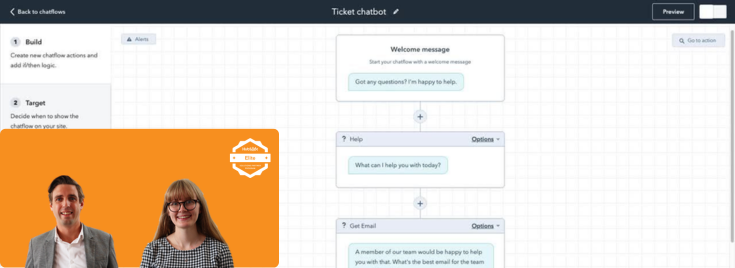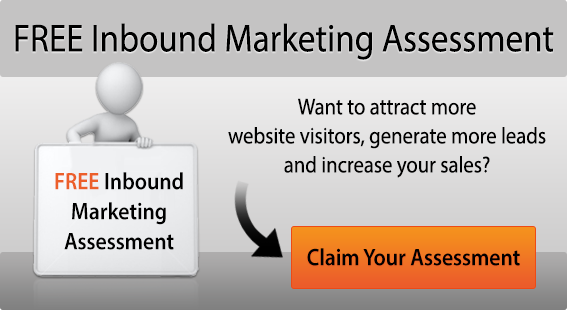Tools That Will Help You Convert Website Visitors Into Customers
by Will Williamson on 13-Sep-2022 12:53:00

The first part of inbound marketing is SEO (search engine optimisation) or PPC (pay per click) advertising, through which you attract more visitors to your website by improving visibility for important search terms. But website visitors on their own are not sales. The second part of inbound marketing is, therefore, conversion rate optimisation (CRO): the process of converting these website visitors into; first – lead enquiries, and second – happy paying customers.
In this article, we look at the tools that will help you maximise your website conversions, focusing mostly – at this stage – on lead generation.
The golden rule of CRO: User Experience (UX)
First, a disclaimer. There aren’t any tools that directly increase conversions (although there are some prompts that encourage them, such as a pop-up window that is triggered whenever a person leaves your site). Instead, you encourage conversions by providing visitors with an excellent user experience (UX), which means giving them the information they need and making it easy for them to get in touch with you.
Why use CRO tools?
CRO tools help you optimise these areas of your website by identifying customer behavioural patterns on site and revealing areas for improvement, e.g.:
- Which pages have the highest and lowest bounce rate
- Where visitors come from before visiting your site (e.g. Google keyword search, paid ad, social media etc)
- The drivers that prompt people to visit your site
- Where your barriers are – factors that cause visitors to leave your site without making contact
- The presence of bugs, broken images, slow performing pages, non-functioning plug-ins etc
- The content angles and messages that give you the best chance of conversion
- The causes of abandoned shopping carts (for ecommerce)
- Whether or not visitors can find the information they are looking for in response to keyword queries
- The pathways visitors take around your website
- Pages that rarely get visited, and why
CRO is, therefore, predominantly a matter of data analytics and testing. Using a good CRO tool gives you access to metrics such as page bounce rate, time spent on site (session duration), pages viewed per visit, proportion of new vs returning visitors, and site speed. As you’ll never get the chance to hear feedback from most website visitors, using CRO provides the customer-centred insights you need to improve your website UX and increase conversions.
What are the best types of CRO tool to use?
There are dozens of CRO tools available, a few free and many paid, and all carrying out different functions with varying levels of success. Some are great, such as Google Analytics and HubSpot – but no business has time to try them all, so instead of reviewing individual platforms here, we’ll explain the general functions of CRO tools to help you narrow your choice. Some platforms cover more than one area:
1) Analytics
Analytics tools reveal the ways in which visitors interact with your site, with Google Analytics being the best-known example of this kind of tool. Metrics you can measure and analyse include session duration, bounce rate, visitor location, traffic type (paid or organic) etc – with each measurement painting a picture of what works and what doesn’t on your site in terms of conversions.
2) A/B testing
A/B testing lets you compare and analyse different types of content – e.g. two versions of different blog articles, adverts, or landing pages – to determine the most successful conversion strategies. A testing tool progresses beyond the insights provided by analytics by letting you test theories and make targeted improvements to your content, all validated by real-time data. By testing content to see which versions get the most interactions, you can focus on the best means of driving conversions and avoid approaches that don’t work as well.
3) Reporting
CRO tools crunch a lot of data about website performance and user behaviour, and this is presented in a variety of ways by different CRO platforms. Many let you generate and download custom reports on a variety of metrics in different written and visual formats, and others utilise intuitive ‘heat maps’ of your site to help you quickly visualise the user experience and identify pain points and barriers to conversion.
4) Added Functions
Some platforms provide tools to directly encourage lead conversions or solicit feedback, by adding specific functions to your website. These include social proof tools, chat bots and live chat apps, surveys, incentive content pop-ups, landing page editors etc.
Convert more website visitors into customers
At JDR, we incorporate conversion rate optimisation into every aspect of content creation, website design, SEO, and paid advertising. If you are disappointed in your website conversions or want to find out how you can gain better results from digital marketing, please speak with one of our team today for an initial assessment of your needs.
Image source: Unsplash
- Inbound Marketing (SEO, PPC, Social Media, Video) (824)
- Strategy (363)
- Sales & CRM (195)
- Marketing Automation & Email Marketing (190)
- Business Growth (164)
- Website Design (160)
- Hubspot (138)
- Lead Generation (115)
- Google Adwords (98)
- Content Marketing (94)
- Conversion (48)
- Case Studies (47)
- News (47)
- Ecommerce (39)
- Webinars (34)
- SEO (24)
- AI (20)
- Events (19)
- Video (17)
- LinkedIn Advertising (15)
- Video Selling (15)
- Software training (13)
- Niche business marketing (11)
- The Digital Prosperity Podcast (10)
- Facebook Advertising (6)
- HubSpot Case Studies (5)
- December 2025 (10)
- November 2025 (6)
- October 2025 (17)
- September 2025 (16)
- August 2025 (14)
- July 2025 (14)
- June 2025 (5)
- May 2025 (19)
- April 2025 (15)
- March 2025 (13)
- February 2025 (13)
- January 2025 (8)
- December 2024 (2)
- November 2024 (4)
- October 2024 (21)
- September 2024 (4)
- August 2024 (8)
- July 2024 (14)
- June 2024 (16)
- May 2024 (25)
- April 2024 (15)
- March 2024 (18)
- February 2024 (5)
- January 2024 (10)
- December 2023 (6)
- November 2023 (10)
- October 2023 (13)
- September 2023 (12)
- August 2023 (14)
- July 2023 (13)
- June 2023 (14)
- May 2023 (15)
- April 2023 (13)
- March 2023 (14)
- February 2023 (13)
- January 2023 (15)
- December 2022 (13)
- November 2022 (6)
- October 2022 (8)
- September 2022 (22)
- August 2022 (15)
- July 2022 (13)
- June 2022 (16)
- May 2022 (14)
- April 2022 (16)
- March 2022 (17)
- February 2022 (11)
- January 2022 (8)
- December 2021 (6)
- November 2021 (7)
- October 2021 (11)
- September 2021 (10)
- August 2021 (7)
- July 2021 (7)
- June 2021 (4)
- May 2021 (4)
- April 2021 (1)
- March 2021 (3)
- February 2021 (5)
- January 2021 (4)
- December 2020 (7)
- November 2020 (6)
- October 2020 (5)
- September 2020 (9)
- August 2020 (18)
- July 2020 (17)
- June 2020 (17)
- May 2020 (10)
- April 2020 (21)
- March 2020 (24)
- February 2020 (21)
- January 2020 (12)
- December 2019 (23)
- November 2019 (12)
- October 2019 (14)
- September 2019 (16)
- August 2019 (15)
- July 2019 (13)
- June 2019 (6)
- May 2019 (8)
- April 2019 (4)
- March 2019 (2)
- February 2019 (2)
- January 2019 (2)
- December 2018 (3)
- November 2018 (24)
- September 2018 (11)
- August 2018 (9)
- June 2018 (3)
- May 2018 (6)
- April 2018 (14)
- March 2018 (12)
- February 2018 (16)
- January 2018 (15)
- December 2017 (15)
- November 2017 (18)
- October 2017 (23)
- September 2017 (19)
- August 2017 (28)
- July 2017 (27)
- June 2017 (25)
- May 2017 (18)
- April 2017 (17)
- March 2017 (16)
- February 2017 (17)
- January 2017 (14)
- December 2016 (21)
- November 2016 (27)
- October 2016 (25)
- September 2016 (16)
- August 2016 (20)
- July 2016 (19)
- June 2016 (14)
- May 2016 (20)
- April 2016 (24)
- March 2016 (22)
- February 2016 (28)
- January 2016 (27)
- December 2015 (28)
- November 2015 (19)
- October 2015 (9)
- September 2015 (12)
- August 2015 (5)
- July 2015 (1)
- June 2015 (10)
- May 2015 (3)
- April 2015 (11)
- March 2015 (14)
- February 2015 (15)
- January 2015 (12)
- December 2014 (2)
- November 2014 (23)
- October 2014 (2)
- September 2014 (2)
- August 2014 (2)
- July 2014 (2)
- June 2014 (7)
- May 2014 (14)
- April 2014 (14)
- March 2014 (7)
- February 2014 (2)
- January 2014 (7)
- December 2013 (9)
- November 2013 (14)
- October 2013 (17)
- September 2013 (3)
- August 2013 (6)
- July 2013 (8)
- June 2013 (4)
- May 2013 (3)
- April 2013 (6)
- March 2013 (6)
- February 2013 (7)
- January 2013 (5)
- December 2012 (3)
- November 2012 (2)
- September 2012 (1)
Subscribe by email
You May Also Like
These Related Blogs

Replay: How To Get More From Live Chat & Automated Chatbots (HubSpot Masterclass)
Adding live chat to your website can mean you provide a faster, more personalised experience for your website visitors. In this webinar you'll discove …

Inbound Marketing Discussion – Should We Try To Benefit From News Trends & Events?
In this instalment of Inbound Marketing Discussions, we're going to look at trends and talk about if you can use them in your digital marketing campai …

Is 2020 The Year Voice Search Changes Digital Marketing?
Voice search has been touted as the next big thing for many years now. It's frequently looked as though it was about to take off – but it's never quit …




